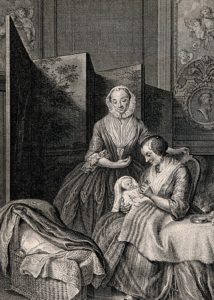Giving Birth in Eighteenth-Century England is the first book in a generation to re-examine the birthing process of women in the long-eighteenth century. It fundamentally revises our historical appreciation of the complexities of how to give birth, all those involved, and the physical dimensions that women experienced from the final stages of pregnancy through to birth and its recovery with their new born.
The chapters explore the historical prism of the rich networks of midwives and gossips that assisted in the birthing room, featuring a cast of neighbours, friends, and kinship groups that were present during confinement and the birthing rituals. All formed part of a much wider sense of community and belonging that worked together to welcome each infant. This meant that the birthing room continued to symbolise the well-being of eighteenth-century society. It was an important way in which local people renewed their community relationships with each other. As Sarah Fox’s excellent study shows, birthing rituals were pivotal to getting involved in a commonplace and yet memorable lifecycle event. Local people developed a personal visible presence, contributed in practical ways, and thus exemplified how being caring and charitable could renew community relations on location. Added to which, such involvement continued to reflect family and religious beliefs that shaped women’s experiences of generation and reproduction in early modern times.
One of the notable strengths of this well-written and timely book is how it represents new narratives researched from neglected archives across the North of England, a region often understudied by social historians. It highlights how some women received strong community support and others were censured for seeking to challenge the cultural status quo of the ritual performance of birthing. Such perspectives remind historians that birthing was not simple or straightforward but a series of physical challenges, shaped by religious and social expectations. Importantly, this novel study stresses how historians have tended to under-appreciate the embodied perspectives of giving birth. Eighteenth-century women had different anatomical make-ups. Pregnancy physiology shaped their particular experiences of the physical constraints of giving birthing safely, over their fertility lifecycle.
Another strikingly novel feature of the monograph is the focus on the material culture of birthing. The fragmentary history of clothing – how to wear fashionable stays, what clothing to wrap the new-born in and the purchasing power of the pregnant women – are illuminating. The neglected histories of food and drink feature too. Renewed focus is placed on how cultures of nourishment can refine our historical appreciation of the importance of cooking, drinking and feeding events in building and maintaining community relationships. Such findings also remind us how much the history of emotions mattered to each pregnant woman and her baby – often feelings of anxiety and fear about the unpredictability of the birth were balanced by a concerted expression of love on the part of close relatives and friends. Such outpourings of loving kindness, once experienced, were seldom forgotten by those present. Not everyone of course was welcomed by the community and the book explores the complexities of cultures of xenophobia, the moral taboo of infanticide, and shifting concepts of insiders/outsiders evolved between the generations.
By the close of this admirable book, it is evident that is has made an important intervention into the literature on early modern childbirth. For it reminds us that birthing was essentially all about a ‘community of neighbours’ and reflected ‘the business of neighbourliness’ – both were integral features of daily life, continuingly renewing social connections in a fast-changing and fascinating eighteenth-century world.
Professor Elizabeth Hurren teaches history at the University of Leicester. She is the author of Hidden Histories of the Dead: Disputed Bodies in Modern British Medical Research (Cambridge University Press, 2021), and many other works.

